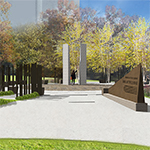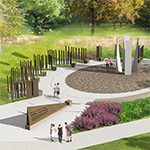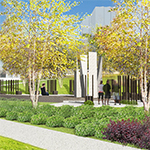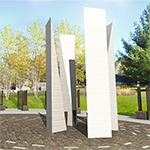Team Moskaliuk
Team members
Wiktor Moskaliuk, Architect, AECOM
Larysa Kurylas, Artist, The Kurylas Studio
Claire Bedat, Landscape Architect, AECOM
Alan Becking, Landscape Architect, AECOM
Design intent
Equality, Freedoms, Justice and Representation. These four principles, which ensure the rights of citizens governed by a democracy, are enshrined in white granite pillars and stand firmly anchored to Canadian bedrock in Ottawa’s Garden of the Provinces and Territories.
The monument is set at the center of a contemplative oval space symbolizing Canadian sanctuary for hundreds of thousands of refugees from communist regimes. Radiating from the core, 200 bronze blades – free-standing noble silhouettes embedded in earth and planting – remind visitors of the triumph of human spirit over the dehumanizing and oppressive nature of communist regimes. Each blade is etched with the surnames of five victims honoured by Canadian families whose 1,000 stories of communist repression will be made accessible via internet linkage. Each blade also stands for 500,000 victims, thus giving form to the estimated 100 million deaths attributed to communism worldwide.
Transcript of the Memorial to victims of communism: Team Moskaliuk video
The visual elements described in this video are in 3D animation.
[Views of Memorial]
Larysa Kurylas (Artist): “Equality, Freedoms, Justice and Representation. These four principles, which ensure the rights of citizens governed by a democracy, are enshrined in white granite pillars and stand firmly anchored to Canadian bedrock in Ottawa’s Garden of the Provinces and Territories.”
[Text on screen:
Equality
Freedom
Justice
Representation]
[Views of Memorial featuring four wedge-shaped pillars in white granite 4 metres in height set within an oval area paved in bedrock, approximately 10 metres in diameter. This area is surrounded by two hundred slim bronze columns 1.8 metre in height called blades, which radiate out in 14 groupings]
[Visitors are shown approaching and looking at the Memorial]
Larysa Kurylas: “From all over the world, victims of communism found refuge in Canada. They found equality of opportunity to seek happiness and success. They found freedoms of religion, speech and assembly, among others. They found justice and fair treatment under the law.”
[View of benches, which face the central oval area, and surrounding plantings]
Larysa Kurylas: “And they found a system of representation guaranteeing the right to self-government.”
Larysa Kurylas: “Democracy safeguards these basic human rights, a fact implicitly understood by the hundreds of thousands of refugees from communist regimes who eventually found dignity living in Canada.”
[Views of visitors walking along pathways through the Garden of the Provinces and Territories leading to the Memorial]
Larysa Kurylas: “The Monument is set at the centre of a contemplative oval space symbolizing Canadian sanctuary.”
[View of entrance to Memorial area featuring large bronze triangular structure with Memorial name and inscription]
Larysa Kurylas: “Radiating from the core, 200 bronze blades -- free-standing noble silhouettes embedded in earth and planting – remind visitors of the triumph of human spirit over the dehumanizing and oppressive nature of communist regimes.”
[View of Memorial illuminated at night]
Larysa Kurylas: “Each blade is etched with the surnames of 5 victims honoured by Canadian families whose 1,000 stories of communist repression will be made accessible via internet linkage. Each blade also stands for 500,000 victims, thus giving form to the estimated 100 million deaths attributed to communism worldwide.”
[Text on screen:
Memorial to the Victims of Communism
Canada, A Land of Refuge
Lead architect/ Project manager
Wiktor Moskaliuk, OAA
AECOM Canada Architects Ltd.
Artist
Larysa Kurylas
The Kurylas Studio
Landscape architect
Claire Bedat, RLA
AECOM]
[AECOM The Kurylas AS Studio]



